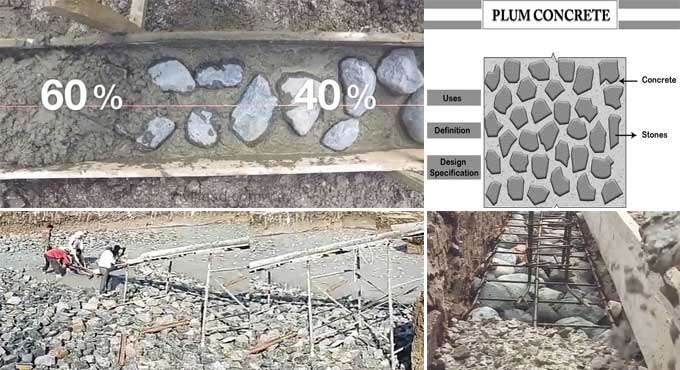
What is Plum concrete & how does it differ from Plain Cement Concrete?

Inert fillers such as large stones up to 300 mm may be used in plum concrete. A plum is an aggregate that exceeds 160 mm in diameter. Plain cement concrete cost can be reduced by thirty percent through the extension of the use of plum and the apparent concrete yield can be increased for a given amount of cement by fifty percent.
It is not backed by steel like reinforced concrete or pre-stressed concrete. There will be boulders up to 300 mm in the Plum Concrete mix ratio. Surface fillers are widely used under foundations with uneven and sloping surfaces.
Plum Concrete Purpose
Concrete plums will be laid beneath the foundation or footing in order to create the requisite surface level. Plum concrete can be used to reduce the cost of plain cement concrete if the thickness is excessive and very large.
This material is commonly used in mass construction such as bridges, gravity dams, and embankment slopes. If you imagine that the ground level on the proposed site is too sloped, and you are unable to fill in the area with soil. The filler material would be plums concrete in that scenario.
Plum Aggregate Characteristics
There is a size range of approximately 150 mm, 200 mm, 300 mm, or larger for natural stones or boulders, such as plum. Materials availability, engineering decisions, and the size of the project all impact the decision.
Plum concrete can be made with angular-shaped stones. A clean surface is essential to ensuring successful adhesion or bonding with concrete. You should ensure it is sound, durable, without defects or segregation, seams, cracks, or any other defects. There should be no wear or weathering, nor should the surface be rounded.
Difference between Plum Concrete & Plain Cement Concrete
A considerable form of concrete is plain cement concrete. Cement, sand, and aggregates are mixed together to make concrete. As a filler material for plum concrete, medium and large stones are employed instead of coarse aggregates as aggregates.
It is the inclusion of boulders in the concrete mix that differentiates plain cement concrete from Plum Concrete. By filling in the gaps, fine aggregates are reduced, and the cost of aggregates is reduced. Thus, plain cement concrete prices decrease as a result of this.
Plum Concreting Construction Process
Surface Leveling & Cleaning: Cleaning and leveling should be done in the suggested area. It is recommended to remove sites with low hearing soft soil.
Surface Waning: Water should be sprayed over the surface to ensure a stronger bond between the concrete and the ground. Sometimes, termite resistance is also maintained with anti-termite treatments.
Components Inspection: It is important that boulders are strong and not flaky. Washing it properly is the best way to clean it.
Boulder & Concrete Placement: There should be adequate gaps between the boulders and the gaps should not exceed 150mm. Concrete will now flow over the boulders, which are gradually spreading between the gaps.
Process Repetition: The process will continue until the surface is uniformly covered with concrete, and then boulders will be kept for retention before concrete is applied.
Curing: You can utilize jute bags to keep the concrete moist while curing for a minimum of two days.
Plum Concrete Applications
1. When the foundation surface is uneven, it is generally appropriate to level the ground under it. As well as smoothing sloped ground, it is also useful for lowering out ruts.
2. The plum size is determined to be 150 mm, but it is utilized to make massive structures such as gravity dams and bridges.
3. In addition to being suitable for the construction of water channels, it is also suitable for surface bed construction.
To learn more, watch the following video tutorial.
Video Source: Everything Civil
4. A huge amount of it is used for the construction of roadways and railway bridges, mainly for the border construction.
5. When mass concrete is required for machine foundations, this material is suitable.


